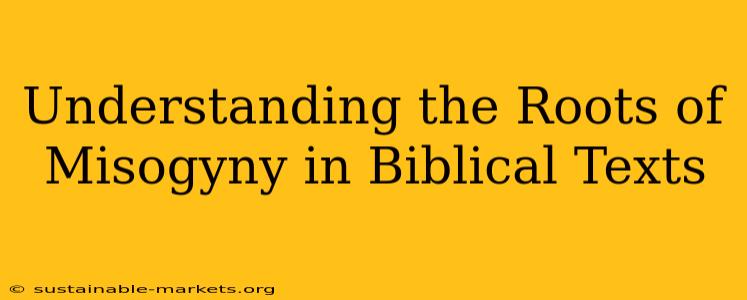The Bible, a collection of texts revered by billions, has been both a source of comfort and a source of contention. While offering messages of love, compassion, and justice, certain interpretations of biblical passages have been used to justify misogyny and patriarchal structures. Understanding these interpretations and their historical context is crucial to disentangling the complexities of this issue and fostering a more inclusive and equitable understanding of the sacred texts. This isn't about condemning the Bible, but about critically examining how certain passages have been – and continue to be – misused.
How Did Misogynistic Interpretations Arise?
The development of misogynistic interpretations of biblical texts is a multifaceted process spanning centuries. Several key factors contribute:
-
Patriarchal Societies: The Bible was written and interpreted within predominantly patriarchal societies where men held dominant positions in families, communities, and religious institutions. This societal framework inevitably shaped the understanding and application of biblical texts, often prioritizing male perspectives and authority.
-
Cultural Context: The historical and cultural contexts surrounding the writing and transmission of biblical texts are paramount. Interpretations that might seem misogynistic today may have been entirely acceptable or even commonplace within their original social and cultural norms. Failing to consider this context leads to anachronistic judgments.
-
Selective Interpretation: The selective use of verses, often out of context, has fueled misogynistic interpretations. Taking isolated passages without considering the broader narrative or the author's intent allows for a biased and often harmful reading.
-
Power Dynamics: Throughout history, powerful individuals and groups have used religious texts to maintain and legitimize their dominance. Interpretations that subordinate women have served to reinforce patriarchal power structures.
What are Some Specific Examples of Misogynistic Interpretations?
Several passages have been cited to support misogynistic viewpoints, often through selective interpretations and biased translations. Let's examine a few:
The Story of Eve and the Fall (Genesis 3):
This narrative is frequently interpreted to blame women for the introduction of sin into the world, portraying Eve as deceitful and responsible for humanity's suffering. However, a closer examination reveals a more nuanced story. Both Adam and Eve share responsibility for their actions, and the narrative itself can be interpreted as exploring themes of temptation, free will, and the consequences of disobedience.
Paul's Letters (1 Corinthians 14:34-35; 1 Timothy 2:11-15):
These passages, often cited to restrict women's roles in the church, are subject to significant debate among biblical scholars. Some argue these passages reflect the cultural norms of their time, while others propose different interpretations that prioritize gender equality. Contextual analysis and consideration of alternative translations are crucial in understanding these complex passages.
Subordination in Marriage (Ephesians 5:22-24; Colossians 3:18; 1 Peter 3:1-6):
These passages, advocating for wives' submission to their husbands, have been used to justify male dominance in marriage. However, arguments exist that these verses call for mutual respect and submission within the marital relationship, rather than hierarchical obedience.
How Can We Interpret These Texts in a More Equitable Way?
Addressing misogynistic interpretations requires a multi-pronged approach:
-
Contextual Analysis: Understanding the historical, cultural, and literary contexts in which these passages were written is critical.
-
Critical Reading: Employing critical reading skills to identify biases, assumptions, and potential misinterpretations is essential.
-
Multiple Interpretations: Acknowledging that multiple interpretations of biblical texts are possible and that not all interpretations are equally valid.
-
Feminist Theology: Engaging with feminist theology and scholarship that offers alternative readings and critiques of traditional interpretations.
-
Focus on Universal Values: Highlighting the Bible's universal messages of love, justice, and equality, and challenging interpretations that contradict these values.
Frequently Asked Questions
Are all interpretations of the Bible misogynistic?
No. Many interpretations of the Bible promote gender equality and challenge patriarchal norms. It's crucial to distinguish between interpretations that align with the Bible's core messages of love and justice and those that perpetuate harmful stereotypes.
How can we reconcile seemingly contradictory passages in the Bible?
Reconciling seemingly contradictory passages requires careful contextual analysis, acknowledging the diversity of voices and perspectives within the Bible, and understanding the complexities of theological interpretation.
What is the role of feminist theology in challenging misogynistic interpretations?
Feminist theology provides valuable tools and frameworks for critically examining and challenging traditional interpretations of biblical texts, offering alternative perspectives that center women's experiences and promote gender equality.
In conclusion, understanding the roots of misogynistic interpretations within biblical texts necessitates a careful and nuanced approach, acknowledging the historical context, engaging in critical analysis, and recognizing the multiplicity of possible interpretations. By adopting a more inclusive and equitable understanding of these texts, we can move towards a more just and compassionate world.

